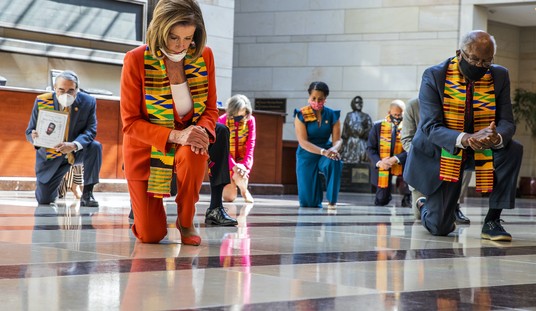One cannot go to Rome without touring the churches. To do so is to miss a great deal of amazing and beautiful art, and to miss the fact that art plays such a large role in Roman life that its operating churches are filled with it, some going back almost a millenium. In other cities, these would be museum pieces; in Rome, it’s the local church where the neighborhood gathers for Mass.
We spent a great deal of time in Rome’s churches, which made our trip seem more like a pilgrimage rather than a vacation at times, especially when we attended the beatification of Pope John Paul II last Sunday in the Vatican, two among two million who came to celebrate. I’ll focus on the four most interesting churches with separate slideshows and brief descriptions. Keep in mind that all of these are working churches, and that they do not charge people for entry to their remarkable entry, so these are simultaneously churches and public museums. (Some have their own museums, which do charge a small fee for entry.)
St. John Lateran
This church is actually the official seat of the Bishop of Rome, not the Vatican or St. Peter’s Basilica. The Lateran Treaty (1929) which allowed the Vatican to exist as its own sovereign state also allowed the Pope to retain control of a few churches in the rest of Rome, and this is one of those churches. The church is covered in frescoes and mosaics, from the medieval period through the Renaissance and Baroque. It has a small museum (which did not allow pictures) that had an entrance fee of one euro each and no English-language guide; I could get through it with my rudimentary Italian, and it had beautiful liturgical pieces and other artifacts from over a millenium of operation in this church. Bear in mind that I wouldn’t use a flash in these churches, due to the frescoes, and it was difficult to get clear shots as a result, but the beauty of the interiors is obvious.
In an annex to the main church are the Holy Stairs or La Scala Sancta. St. Helena, mother of the first Christian emperor Constantine, traveled to Jerusalem and brought back many artifacts, including the steps to Pontius Pilate’s palace, which tradition holds are the same that Jesus used to walk to his condemnation. Pilgrims go up the stairs on their knees, which both Marcia and I did — and ended up getting assistance from a very sweet and amazingly fit nun in her 60s. Talk about a humbling experience! At the top of the steps is an ancient papal reading room known as the Sancta Sanctorum. The last few shots show these.
Santa Maria Maggiore
One of the oldest and most important churches in Rome, its main architecture goes back to the 5th century. Its facades are from the Baroque period. It is, I believe, the oldest church building in Rome outside of the Pantheon, which was converted to Christian use and not built for that purpose, obviously. The church has had additions since its 5th century construction (the Roman columns along the naves are original, for instance). The mosaics along the nave and the apse tell stories from the Old Testament that relate to Abraham, Moses, and the harbingers of the coming of Christ, as well as some New Testament (and Apocrypha) scenes. The frescoes are Renaissance additions made by sealing windows along the nave, and are all New Testament depictions. Like most basilicas, this has a number of chapels and a baptistry, the latter of which has an amber covering over a window that makes for a beautiful setting. The artist Gian Lorenzo Bernini, who is so important to Vatican, Roman, and other church architecture and art, is buried near the altar of this church.
The lower altar is a masterpiece of mosaics that are exquisite and stunning — and very, very difficult to photograph correctly. While I was trying to get good shots, a group of Polish students (teens and preteens) gathered around and sang a beautiful hymn in Polish. It was a beautiful experience, and one I will not soon forget
The Pantheon
This is more known for its mind-boggling architecture rather than as a place of worship, and I suspect that’s true for Romans as well. Of all the churches we visited, this one was the least church-like. It also had a number of important pieces of art, but the setting seems more sterile and, well, touristy. It’s definitely worth the visit for its architecture, though, and spend a few euros to get the audio guide when you visit. The artist Raphael is buried here, and his sarcophagus is easily viewed.
Santa Maria in Trastevere
This is the one church that I knew I had to make time to see in Rome (other than the Vatican, which I’ll discuss in a later post). It’s the site of the first more-or-less officially tolerated, openly Christian church in Rome, dating back to the early third century. The current building goes back to the 12th century using a fourth-century floor plan. Unlike St. John Lateran or Santa Maria Maggiore, this church didn’t get a Renaissance or Baroque facade. It is squeezed into a neighborhood between residential buildings, facing a small square with trattorie and other small shops. It’s easily the most humble church from the outside that we visited in Rome, but the interior is amazing.
Most of the art are mosaics from the medieval period, but there are some Renaissance additions along the nave. It has a portrait of Peter’s crucifixion that seems to date from the early Renaissance in an area just outside of a chapel, and a very early mosaic of a Madonna, which was undated but obviously ancient. While we visited, no services were taking place, but a cantor sang a chant a cappella, which gave the visit a definite liturgical feel. We enjoyed this tremendously despite being out of the way, across the Tiber, from the rest of the sights we intended to visit that day. In fact, our next visit after this was a brief look at Campo di Fiori, and then the Pantheon.








Join the conversation as a VIP Member